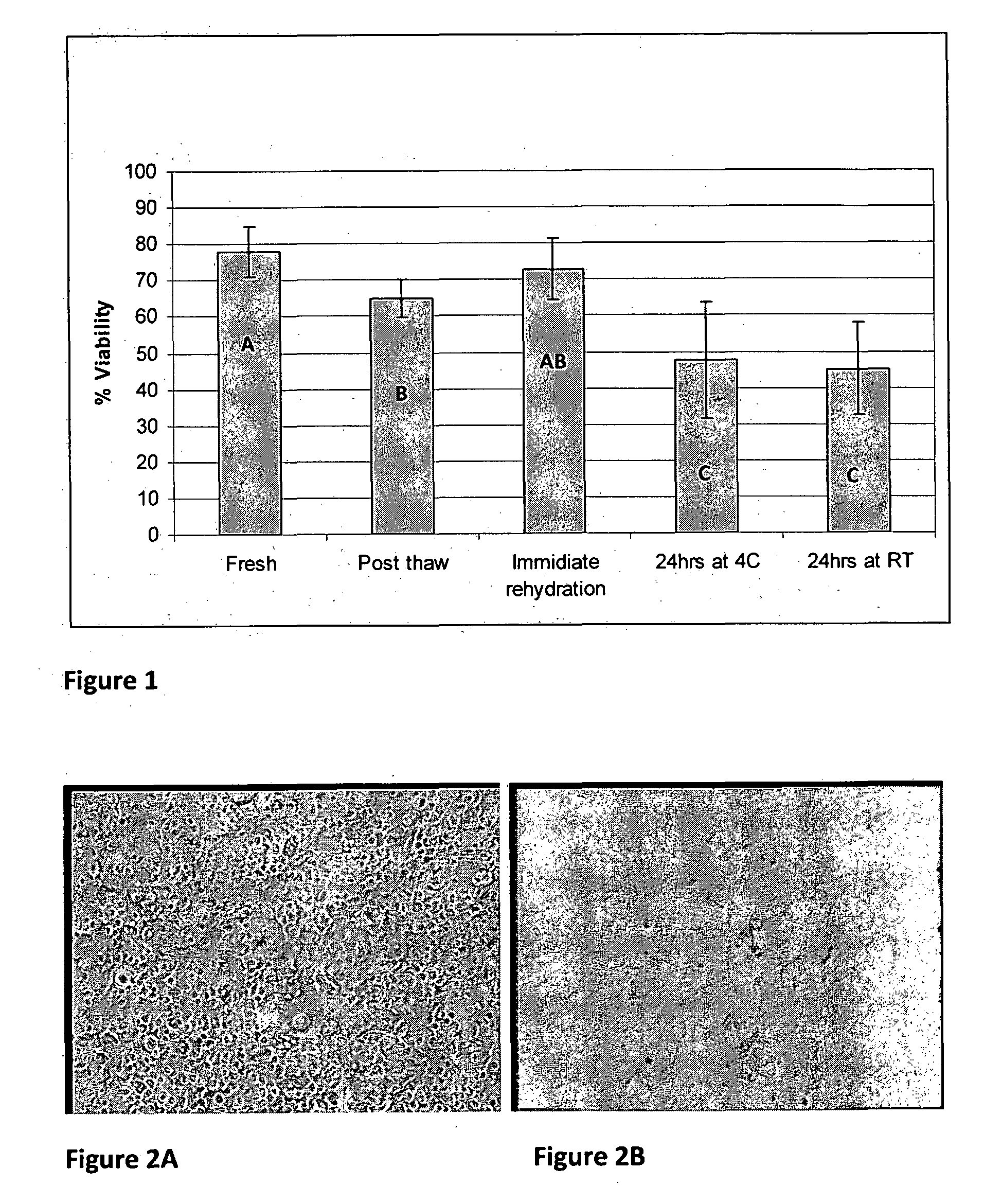Method for preserving cancellous bone samples and preserved cancellous bone tissue
a cancellous bone and tissue technology, applied in the field of cryopreserving cancellous bone samples, can solve the problems that bone grafts (or other treatments) have not demonstrated osteogenic capabilities
- Summary
- Abstract
- Description
- Claims
- Application Information
AI Technical Summary
Benefits of technology
Problems solved by technology
Method used
Image
Examples
example 1
[0080]In a first experiment the following groups were prepared:[0081]1) Disks frozen with IMT-2 solution[0082]2) Disks frozen with IMT-3 solution[0083]3) Chips frozen with IMT-2 solution[0084]4) Chips frozen with IMT-3 solution
[0085]From each group 2 samples were frozen and one was thawed (“freeze thaw” sample) and the other lyhophilized and re-hydrated (“freeze-dry” sample) lyophilized. A total of 8 samples were frozen.
TABLE 1cell concentration* and viability of bone samples following freezingand thawing or freeze-drying and rehydrationBone DisksBone ChipsCellCellConcen-Concen-ProcedureSolutiontrationViabilitytrationViabilityFreezeIMT-250% of fresh25%-30%50% of fresh25%-30%thawFreezeIMT-3Similar to40%-50%Similar to40%-50%thawfreshfreshFreeze dryIMT-230% of fresh10%-20%30% of fresh 1%-20%Freeze dryIMT-380% of fresh40%-50%80% of fresh40%-50%*The cell concentration was normalized (estimated) relative to the concentration in the fresh sample, prior to mixing with the freezing solution....
example 2
[0089]In a second experiment, bone disks frozen with IMT-3 solution were examined. Some samples were examined after freezing and some samples after lyophilization and storage for 24 hours either at room temperature (RT) or in refrigeration (˜4° C.). Viability was assayed using confocal microscopy as well as inverted microscope and freeze dried samples were place in culture before or after storage in order to evaluate the ability of the cells to migrate and proliferate after freeze drying.
[0090]A total of 11 bone disk samples were frozen in test tubes according to the following description:
TABLE 2sample preparationsStorageTube #Procedure(duration / temp)Assay1Freeze-Thawing0Viability2Freeze-Drying0Viability3Freeze-Drying0Viability4Freeze-Drying0Viability5Freeze-Drying0Culture6Freeze-Drying0Culture7Freeze-Drying0Culture8Freeze-Drying24 hrs / RTViability9Freeze-Drying24 hrs / RTCulture10Freeze-Drying24 hrs / 4° C.Viability11Freeze-Drying24 hrs / 4° C.Culture
[0091]FIG. 1 provides bone disks viabi...
example 3
[0098]In a third experiment, the same conditions as in the second one took place, only with storage for 4 days at refrigeration (4° C.). Furthermore, each disk sample was assayed both for viability and for culture.
[0099]The bone disk samples were processed as follows in Table 4.
TABLE 4Sample preparation:Tube #ProcedureStorageAssay1ThawingNo storageViability & culture2Freeze-dryingNo storageViability & culture3Freeze-dryingNo storageViability & culture4Freeze-drying4 days at 4° C.Viability & culture
[0100]The cell viability of the different samples is provided in Table 5. Viability was determined by live / dead stains and microscope observation.
TABLE 5Viability AssayAfter4 daysPriorImmediatestorageFreshFreezingPost ThawRehydration*at 4° C.86.92% ± 7.7%86.8% ± 2.6%83.8% ±67.09% ±>50%**2.8%14.2%*the value is an average of samples 2 and 3**this sample could not be observed using confocal microscope or regular UV microscope therefore the viability was only estimated by morphological observa...
PUM
| Property | Measurement | Unit |
|---|---|---|
| thickness | aaaaa | aaaaa |
| width | aaaaa | aaaaa |
| temperature | aaaaa | aaaaa |
Abstract
Description
Claims
Application Information
 Login to View More
Login to View More - R&D
- Intellectual Property
- Life Sciences
- Materials
- Tech Scout
- Unparalleled Data Quality
- Higher Quality Content
- 60% Fewer Hallucinations
Browse by: Latest US Patents, China's latest patents, Technical Efficacy Thesaurus, Application Domain, Technology Topic, Popular Technical Reports.
© 2025 PatSnap. All rights reserved.Legal|Privacy policy|Modern Slavery Act Transparency Statement|Sitemap|About US| Contact US: help@patsnap.com

